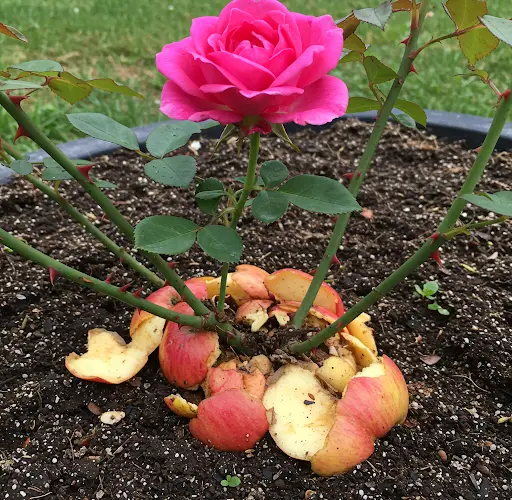In the world of gardening, nature often provides unexpected solutions in the most overlooked places. One of those hidden treasures? Apple peels. Instead of tossing them in the compost or trash, consider saving them—because they might just be the key to successfully propagating your roses at home.
Apple peels are not only packed with nutrients but also contain natural growth-stimulating compounds that can help rose cuttings root faster and healthier. If you’re trying to grow new rose plants from cuttings, this easy, eco-friendly method can offer surprisingly positive results.
Why Apple Peels Work for Propagation
Apple peels are rich in sugars, vitamins, and trace elements. Most notably, they contain natural plant hormones, including small amounts of auxins, which are essential for root development. These compounds stimulate cell division and elongation—exactly what a young cutting needs to produce roots.
Additionally, apple peels have antimicrobial properties that help protect cuttings from rotting, a common problem during propagation. Instead of using synthetic rooting hormones, you can rely on this natural, biodegradable solution that’s already in your kitchen.
What You’ll Need
To get started, gather the following materials:
-
Fresh rose cuttings (6–8 inches in length)
-
Peels from 1–2 organic apples
-
A blender or mortar and pestle
-
Clean water
-
Planting pots or trays
-
Well-draining propagation mix (e.g., sand, coco peat, or a perlite-soil mix)
-
A plastic bag or container to cover (for humidity)
Step-by-Step Guide to Propagating Roses with Apple Peels
1. Prepare the Rose Cuttings
Choose healthy stems from a mature rose bush. The ideal cutting is about 6 to 8 inches long and has at least 3 nodes (where leaves grow).
-
Use clean, sharp pruning shears to cut just below a node.
-
Remove any flowers, buds, and the lower leaves.
-
Leave only the top 1–2 leaves to aid in minimal photosynthesis.
-
Optionally, make a shallow vertical slit at the base of the cutting to expose more rooting surface.
2. Make the Apple Peel Solution
Take the apple peels and blend them with a small amount of water—just enough to create a thick, pulpy mixture. If you don’t have a blender, finely chop or mash the peels using a mortar and pestle.
Strain the mixture through a sieve or cheesecloth to collect the nutrient-rich liquid. This will be used to soak the cuttings and nourish the rooting zone.
3. Soak the Cuttings
Place the base of each rose cutting into the apple peel liquid. Let them soak for about 30–45 minutes. This allows the natural hormones and sugars to be absorbed into the plant tissue.
This step boosts the likelihood of rapid root formation once the cutting is planted in the growing medium.
4. Plant the Cuttings
Fill pots or a seedling tray with your chosen propagation mix. Make a small hole in the center of each pot.
-
Remove the cuttings from the apple peel soak and gently shake off any excess liquid.
-
Insert the bottom third of each cutting into the soil and press the medium lightly around it.
-
Mist the soil lightly to moisten it, but avoid overwatering.
5. Create a Mini Greenhouse
Cover each pot or tray with a plastic bag or place it under a clear plastic container to create a greenhouse-like environment. This maintains humidity, which is essential for root development.
Set the covered pots in a bright, warm area out of direct sunlight. Too much heat can cause wilting or fungal problems.
Care and Maintenance
Check your cuttings daily to ensure the soil remains lightly moist. Mist with water if necessary. Open the cover for 10–15 minutes each day to allow air circulation and prevent mold.
In 2 to 3 weeks, you may notice new leaves forming. This is a good sign that roots are developing. Gently tug on the cuttings—if you feel resistance, rooting has occurred.
Once the new plant is well established, remove the cover and begin gradually introducing it to more direct sunlight.
Extra Tips for Success
-
Use only fresh, organic apple peels to avoid pesticides or waxes that could harm the plant.
-
Propagate during spring or early summer for the best rooting conditions.
-
Always use clean tools and containers to reduce the risk of fungal infections.
-
Don’t overwater—moist, not soggy, soil is ideal.
Final Thoughts
Apple peels may seem like kitchen waste, but they’re actually a powerhouse of natural nutrients and growth hormones. By incorporating them into your rose propagation routine, you’re not only recycling effectively but also tapping into a gentle, organic method to encourage strong, healthy root development.
Whether you’re an experienced gardener or just starting out, this method offers a simple, cost-free way to grow more of the roses you love—right from home.



